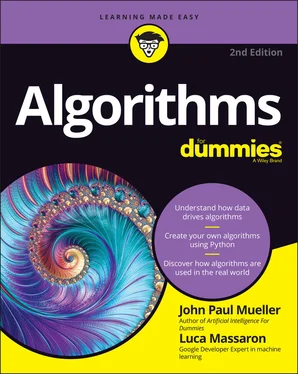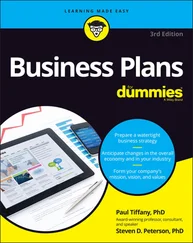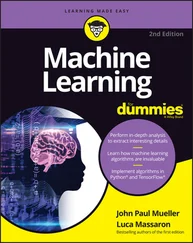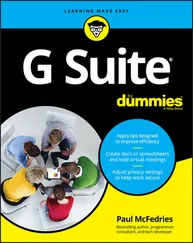John Paul Mueller - Algorithms For Dummies
Здесь есть возможность читать онлайн «John Paul Mueller - Algorithms For Dummies» — ознакомительный отрывок электронной книги совершенно бесплатно, а после прочтения отрывка купить полную версию. В некоторых случаях можно слушать аудио, скачать через торрент в формате fb2 и присутствует краткое содержание. Жанр: unrecognised, на английском языке. Описание произведения, (предисловие) а так же отзывы посетителей доступны на портале библиотеки ЛибКат.
- Название:Algorithms For Dummies
- Автор:
- Жанр:
- Год:неизвестен
- ISBN:нет данных
- Рейтинг книги:3 / 5. Голосов: 1
-
Избранное:Добавить в избранное
- Отзывы:
-
Ваша оценка:
- 60
- 1
- 2
- 3
- 4
- 5
Algorithms For Dummies: краткое содержание, описание и аннотация
Предлагаем к чтению аннотацию, описание, краткое содержание или предисловие (зависит от того, что написал сам автор книги «Algorithms For Dummies»). Если вы не нашли необходимую информацию о книге — напишите в комментариях, мы постараемся отыскать её.
Algorithms For Dummies,
Algorithms For Dummies
Algorithms For Dummies — читать онлайн ознакомительный отрывок
Ниже представлен текст книги, разбитый по страницам. Система сохранения места последней прочитанной страницы, позволяет с удобством читать онлайн бесплатно книгу «Algorithms For Dummies», без необходимости каждый раз заново искать на чём Вы остановились. Поставьте закладку, и сможете в любой момент перейти на страницу, на которой закончили чтение.
Интервал:
Закладка:
Throughout this book, you see the same three elements for every algorithm:
1 Describe the problem.
2 Create a series of steps to solve the problem (well defined).
3 Perform the steps to obtain a desired result (finite and effective).
Using Computers to Solve Problems
The term computer sounds quite technical and possibly a bit overwhelming to some people, but people today are neck deep (possibly even deeper) in computers. You wear at least one computer, your smartphone, most of the time. If you have any sort of special device, such as a pacemaker, it also includes a computer. A car can contain as many as 150 computers in the form of embedded microprocessors that regulate fuel consumption, engine combustion, transmission, steering, and stability (see https://spectrum.ieee.org/software-eating-car for details), provide Advanced Driver-Assist Systems (ADAS), and more lines of code than a jet fighter. A computer exists to solve problems quickly and with less effort than solving them manually. Consequently, it shouldn’t surprise you that this book uses still more computers to help you understand algorithms better.
Computers vary in a number of ways. The computer in a watch is quite small; the one on a desktop quite large. Supercomputers are immense and contain many smaller computers all tasked to work together to solve complex issues, such as predicting tomorrow’s weather. The most complex algorithms rely on special computer functionality to obtain solutions to the issues people design them to solve. Yes, you could use lesser resources to perform the task, but the trade-off is waiting a lot longer for an answer, or getting an answer that lacks sufficient accuracy to provide a useful solution. In some cases, you wait so long that the answer is no longer important. With the need for both speed and accuracy in mind, the following sections discuss some special computer features that can affect algorithms.
Getting the most out of modern CPUs and GPUs
General-purpose processors, CPUs, started out as a means to solve problems using algorithms. However, their general-purpose nature also means that a CPU can perform a great many other tasks, such as moving data around or interacting with external devices. A general-purpose processor does many things well, which means that it can perform the steps required to complete an algorithm, but not necessarily fast. Owners of early general-purpose processors could add math coprocessors (special math-specific chips) to their systems to gain a speed advantage (see https://www.computerhope.com/jargon/m/mathcopr.htm for details). Today, general-purpose processors have the math coprocessor embedded into them, so when you get an Intel i9 processor, you actually get multiple processors in a single package.
A GPU is a special-purpose processor with capabilities that lend themselves to faster algorithm execution. For most people, GPUs are supposed to take data, manipulate it in a special way, and then display a pretty picture onscreen. However, any computer hardware can serve more than one purpose. It turns out that GPUs are particularly adept at performing data transformations, which is a key task for solving algorithms in many cases. It shouldn’t surprise you to discover that people who create algorithms spend a lot of time thinking outside the box, which means that they often see methods of solving issues in nontraditional approaches.
The point is that CPUs and GPUs form the most commonly used chips for performing algorithm-related tasks. The first performs general-purpose tasks quite well, and the second specializes in providing support for math-intensive tasks, especially those that involve data transformations. Using multiple cores makes parallel processing (performing more than one algorithmic step at a time) possible. Adding multiple chips increases the number of cores available. Having more cores adds speed, but a number of factors keeps the speed gain to a minimum. Using two i9 chips won’t produce double the speed of just one i9 chip.
Working with special-purpose chips
A math coprocessor and a GPU are two examples of common special-purpose chips in that you don’t see them used to perform tasks such as booting the system. However, algorithms often require the use of uncommon special-purpose chips to solve problems. This isn’t a hardware book, but it pays to spend time showing you all sorts of interesting chips, such as the artificial neurons that UCSD is working on ( https://www.marktechpost.com/2021/06/03/ucsd-researchers-develop-an-artificial-neuron-device-that-could-reduce-energy-use-and-size-of-neural-network-hardware/ ). Imagine performing algorithmic processing using devices that simulate the human brain. It would create an interesting environment for performing tasks that might not otherwise be possible today.
Neural networks, a technology that is used to simulate human thought and make deep learning techniques possible for machine learning scenarios, are now benefitting from the use of specialized chips (the article at https://analyticsindiamag.com/top-10-gpus-for-deep-learning-in-2021/ outlines ten of them). These kinds of chips not only perform algorithmic processing extremely fast but also learn as they perform the tasks, making them faster still with each iteration. Learning computers will eventually power robots that can move (after a fashion) on their own, akin to the robots seen in the movie I Robot. Some robots even sport facial expressions now ( https://www.sciencedaily.com/releases/2021/05/210527145244.htm ).
 No matter how they work, specialized processors will eventually power all sorts of algorithms that will have real-world consequences. You can already find many of these real-world applications in a relatively simple form. For example, imagine the tasks that a pizza-making robot would have to solve — the variables it would have to consider on a real-time basis. This sort of robot already exists (this is just one example of the many industrial robots used to produce material goods by employing algorithms), and you can bet that it relies on algorithms to describe what to do, as well as on special chips to ensure that the tasks are done quickly (
No matter how they work, specialized processors will eventually power all sorts of algorithms that will have real-world consequences. You can already find many of these real-world applications in a relatively simple form. For example, imagine the tasks that a pizza-making robot would have to solve — the variables it would have to consider on a real-time basis. This sort of robot already exists (this is just one example of the many industrial robots used to produce material goods by employing algorithms), and you can bet that it relies on algorithms to describe what to do, as well as on special chips to ensure that the tasks are done quickly ( https://www.therobotreport.com/picnic-pizza-making-robot-is-now-available/ ).
 Eventually, it might even be possible to use the human mind as a processor and output the information through a special interface. At one point, people experimented with putting processors directly into the brain, but the latest innovation relies on the use of veins to make the connection (
Eventually, it might even be possible to use the human mind as a processor and output the information through a special interface. At one point, people experimented with putting processors directly into the brain, but the latest innovation relies on the use of veins to make the connection ( https://www.independent.co.uk/life-style/gadgets-and-tech/brain-computer-interface-vein-als-stent-neuralink-b1556167.html ). Imagine a system in which humans can solve problems using algorithms at the speed of computers, but with the creative “what if” potential of humans.
Networks: Sharing is more than caring
Unless you have unlimited funds, using some algorithms effectively may not be possible, even with specialized chips. In that case, you can network computers together. Using special software, one computer, a host, can use the processors of all client computers running an agent (a kind of in-memory background application that makes the processor available). Using this approach, you can solve incredibly complex problems by offloading pieces of the problem to a number of client computers. As each computer in the network solves its part of the problem, it sends the results back to the host, which puts the pieces together to create a consolidated answer, a technique called cluster computing.
Читать дальшеИнтервал:
Закладка:
Похожие книги на «Algorithms For Dummies»
Представляем Вашему вниманию похожие книги на «Algorithms For Dummies» списком для выбора. Мы отобрали схожую по названию и смыслу литературу в надежде предоставить читателям больше вариантов отыскать новые, интересные, ещё непрочитанные произведения.
Обсуждение, отзывы о книге «Algorithms For Dummies» и просто собственные мнения читателей. Оставьте ваши комментарии, напишите, что Вы думаете о произведении, его смысле или главных героях. Укажите что конкретно понравилось, а что нет, и почему Вы так считаете.












